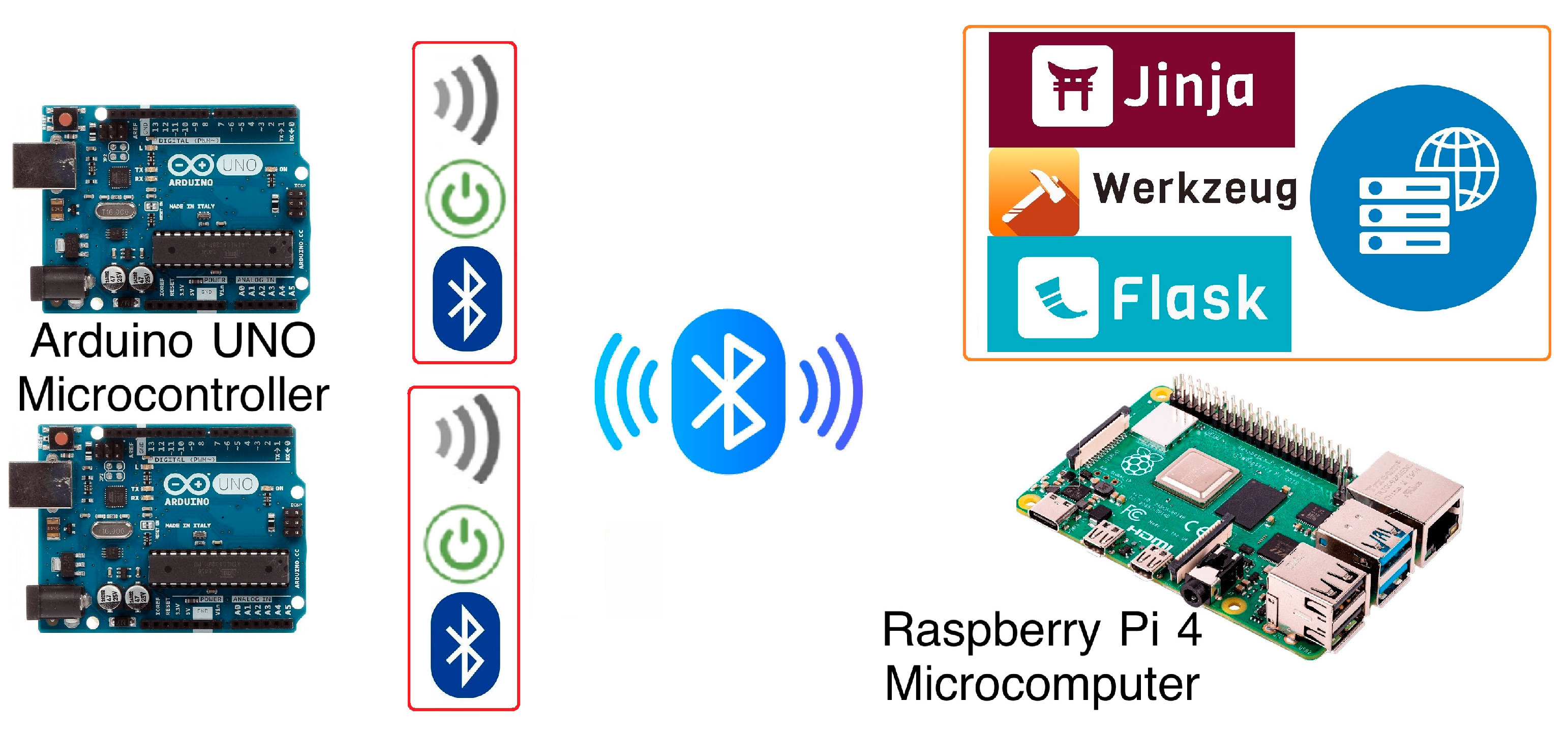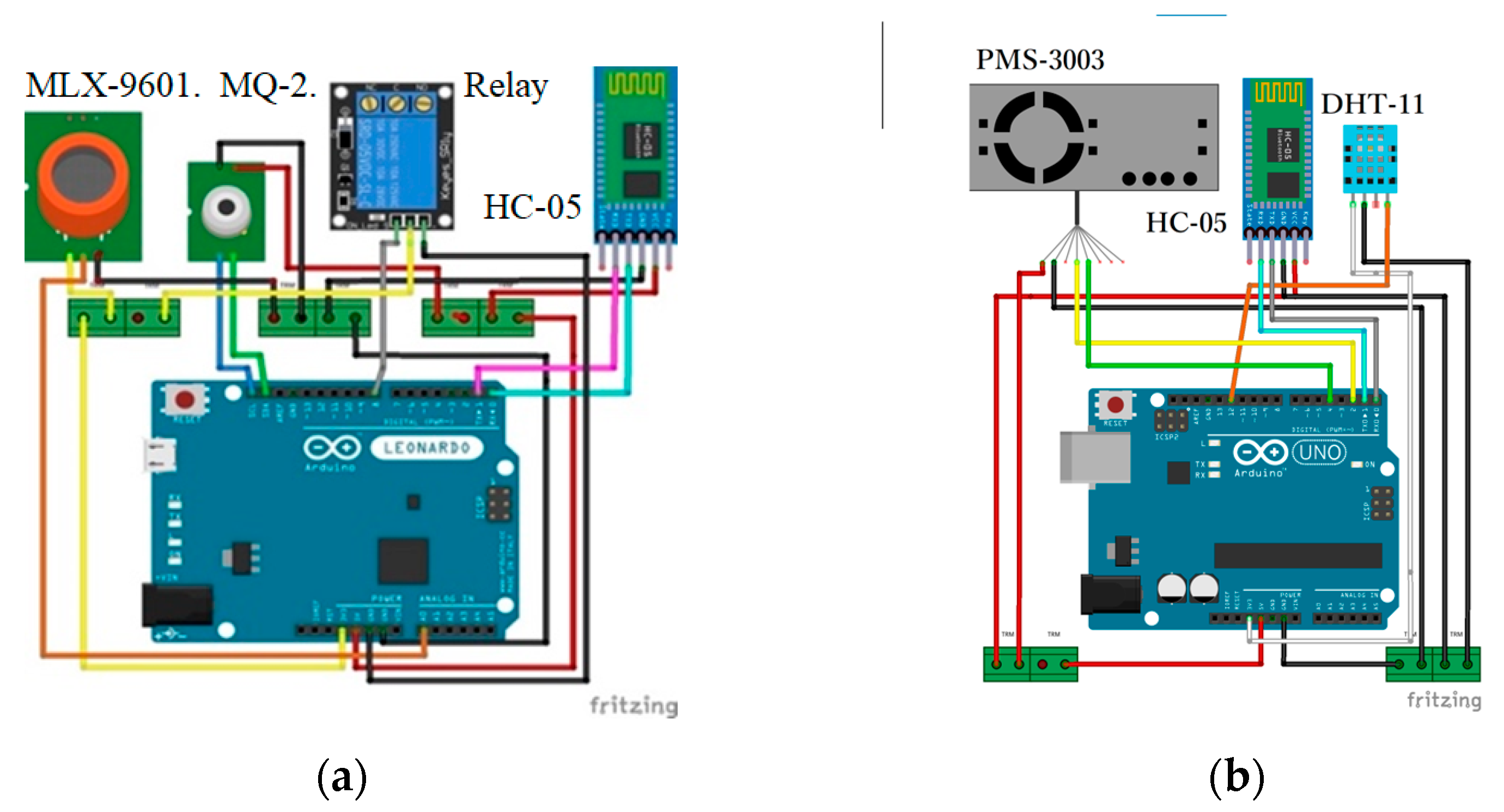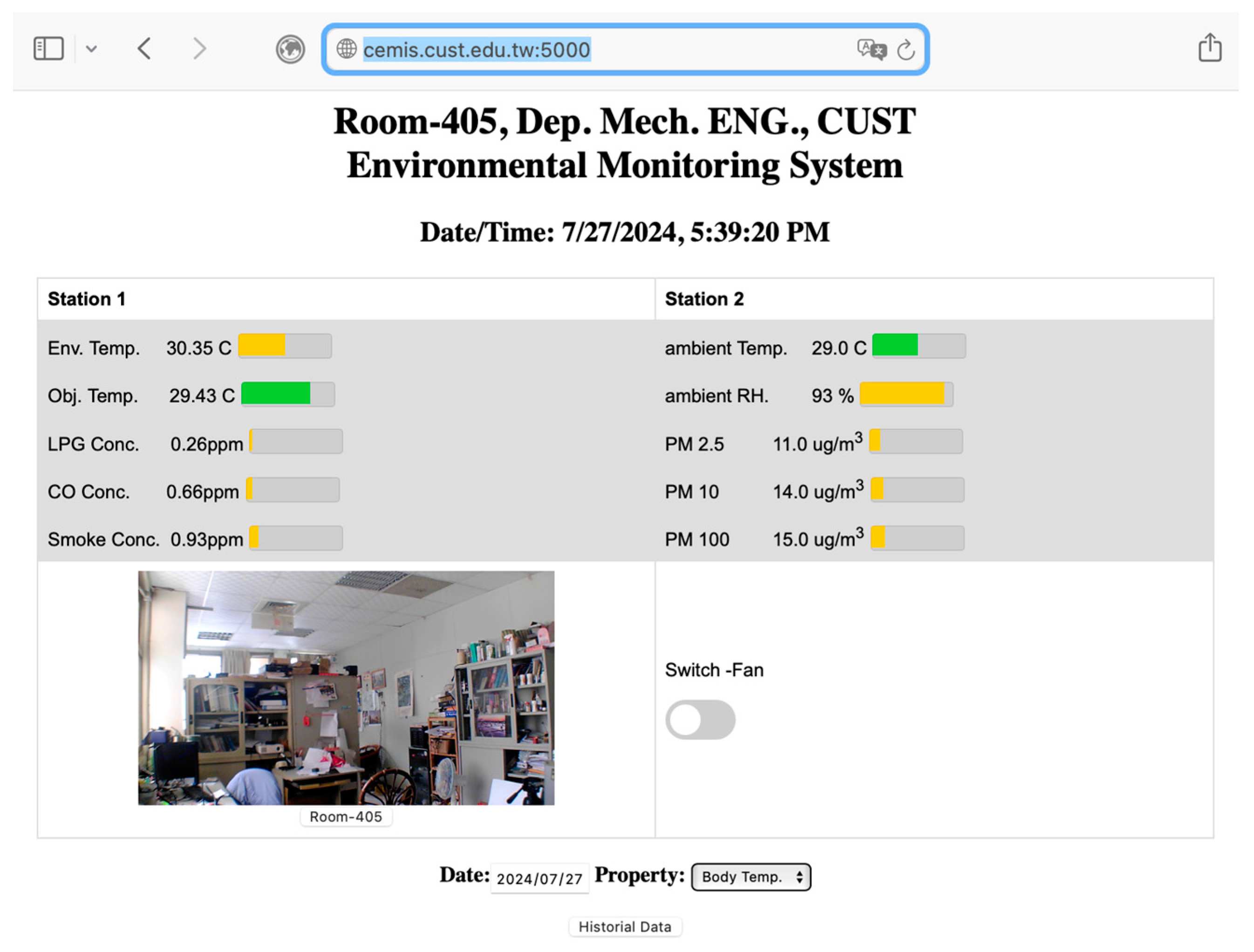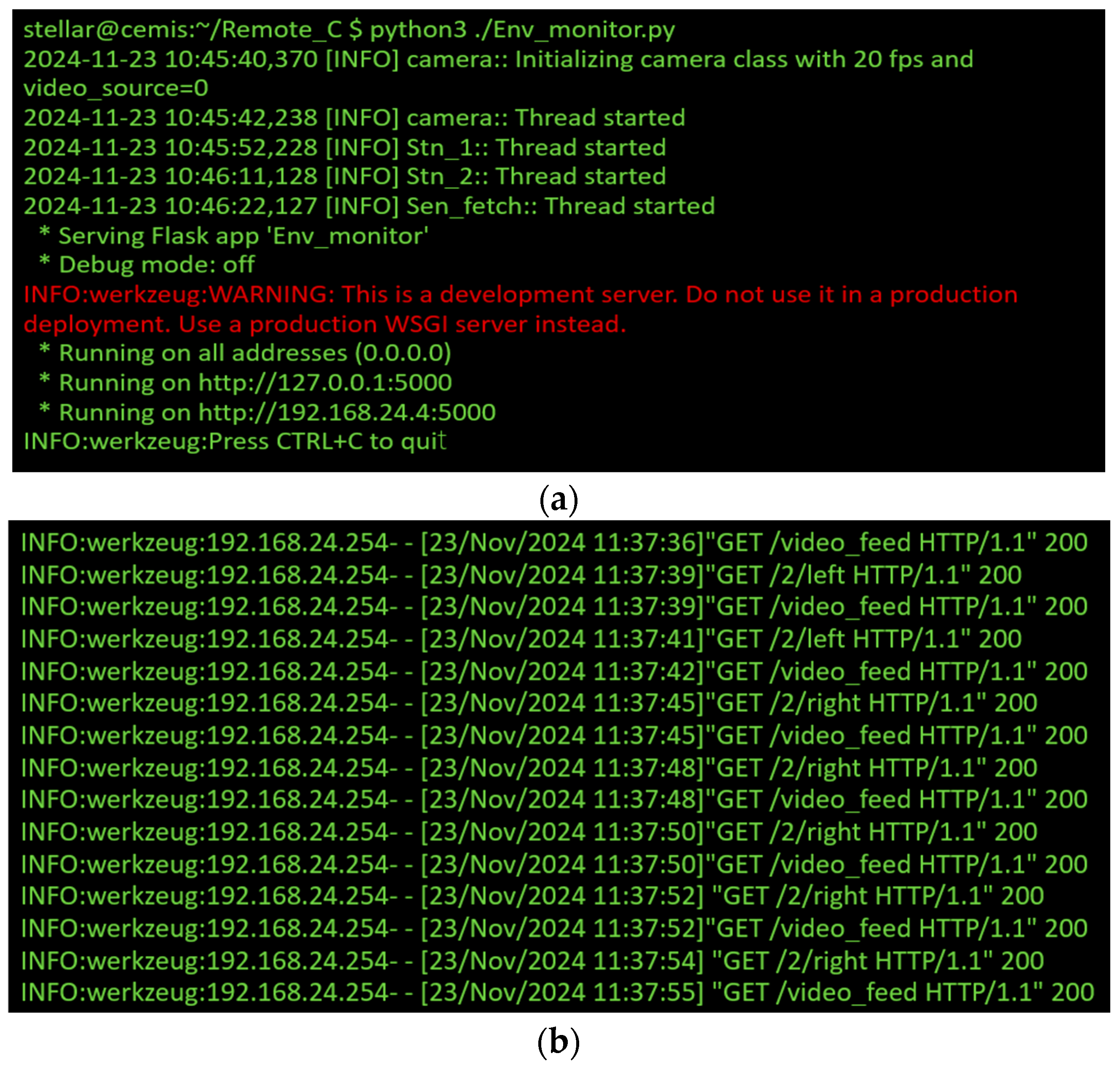Design and Implementation of Environmental Monitoring System Using Flask-Based Web Application †
Abstract
1. Introduction
2. System Architecture
2.1. Microcontrollers and Sensors
2.2. Micro-Frame Web Application
2.3. Wireless Sensor Network
3. Implement and Testing
4. Conclusions
Funding
Institutional Review Board Statement
Informed Consent Statement
Data Availability Statement
Conflicts of Interest
References
- Internet of Things in Retail Market Size, Share, and Trends 2024 to 2034. Available online: https://www.precedenceresearch.com/iot (accessed on 10 November 2024).
- IoT Platform Market Size, Share & Trends Analysis Report and Segment Forecasts, 2024–2030. Available online: https://www.grandviewresearch.com/industry-analysis/iot-platform-market-report (accessed on 10 November 2024).
- Gupta, S.; Tanwar, S.; Gupta, N. A Systematic Review on Internet of Things (IoT): Applications & Challenges. In Proceedings of the 10th International Conference on Reliability, Infocom Technologies and Optimization (Trends and Future Directions) (ICRITO), Noida, India, 13–14 October 2022; pp. 1–7. [Google Scholar] [CrossRef]
- García, L.; Garcia-Sanchez, A.-J.; Asorey-Cacheda, R.; Garcia-Haro, J.; Zúñiga-Cañón, C.-L. Smart Air Quality Monitoring IoT-Based Infrastructure for Industrial Environments. Sensors 2022, 22, 9221. [Google Scholar] [CrossRef] [PubMed]
- Monios, N.; Peladarinos, N.; Cheimaras, V.; Papageorgas, P.; Piromalis, D.-D. A Thorough Review and Comparison of Commercial and Open-Source IoT Platforms for Smart City Applications. Electronics 2024, 13, 1465. [Google Scholar] [CrossRef]
- Bouzakis, A. Scaling Challenges of High-Tech SMEs developing Internet of Things Technology. In Proceedings of the International Conference on Engineering Management of Communication and Technology (EMCTECH), Vienna, Austria, 20–22 October 2021; pp. 1–5. [Google Scholar] [CrossRef]
- Morchid, A.; Jebabra, R.; Abdulla Ismail, A.; Khalid, H.-M.; Alami, R.; Qjidaa, H.; Jamil, M.O. IoT-enabled fire detection for sustainable agriculture: A real-time system using flask and embedded technologies. Results Eng. 2024, 23, 102705. [Google Scholar] [CrossRef]
- Yu, Q.; Xiong, F.; Wang, Y.-R. Integration of Wireless Sensor Network and IoT for Smart Environment Monitoring System. J. Interconnect Netw. 2022, 22 (Suppl. S2), 2143010. [Google Scholar] [CrossRef]
- Bell, C. Beginning Sensor Networks with XBee, Raspberry Pi, and Arduino; Apress: Berkeley, CA, USA, 2020; pp. 557–638. [Google Scholar]
- Pallets Project. Available online: https://palletsprojects.com/ (accessed on 21 March 2023).
- Garg, V.-K. Chap. 19. In Wireless Communications & Networking; The Morgan Kaufmann: Amsterdam, The Netherlands, 2007. [Google Scholar]
- Labiod, H.; Afifi, H.; De Santis, C. Chap. 6. In Wi-Fi, Bluetooth, Zigbee and Wimax; Springer: Dordrecht, The Netherlands, 2007. [Google Scholar]
- Plotpy. Available online: https://plotly.com/ (accessed on 20 July 2024).
 and
and  are indicated as a sensor and an actuator, respectively).
are indicated as a sensor and an actuator, respectively).
 and
and  are indicated as a sensor and an actuator, respectively).
are indicated as a sensor and an actuator, respectively).






| Platform | Micro-Controller | Sensor and Actuator | Interface |
|---|---|---|---|
| Master server | Raspberry Pi 4 Model B | WebCam Servo Motor | USB-2 I2C (PWM) |
| Sensor node 1 | Arduino UNO 3 | MLX9061 (Temperature) MQ-2 (Gas detector) Keyes104C06 (Relay) | I2C Analog output Digital output |
| Sensor node 2 | Arduino UNO 3 | DTH-11 (Temperature) PMS 3003 (Particulate matter) | Analog output Serial port |
Disclaimer/Publisher’s Note: The statements, opinions and data contained in all publications are solely those of the individual author(s) and contributor(s) and not of MDPI and/or the editor(s). MDPI and/or the editor(s) disclaim responsibility for any injury to people or property resulting from any ideas, methods, instructions or products referred to in the content. |
© 2025 by the author. Licensee MDPI, Basel, Switzerland. This article is an open access article distributed under the terms and conditions of the Creative Commons Attribution (CC BY) license (https://creativecommons.org/licenses/by/4.0/).
Share and Cite
Hong, R.-T. Design and Implementation of Environmental Monitoring System Using Flask-Based Web Application. Eng. Proc. 2025, 92, 37. https://doi.org/10.3390/engproc2025092037
Hong R-T. Design and Implementation of Environmental Monitoring System Using Flask-Based Web Application. Engineering Proceedings. 2025; 92(1):37. https://doi.org/10.3390/engproc2025092037
Chicago/Turabian StyleHong, Rong-Tai. 2025. "Design and Implementation of Environmental Monitoring System Using Flask-Based Web Application" Engineering Proceedings 92, no. 1: 37. https://doi.org/10.3390/engproc2025092037
APA StyleHong, R.-T. (2025). Design and Implementation of Environmental Monitoring System Using Flask-Based Web Application. Engineering Proceedings, 92(1), 37. https://doi.org/10.3390/engproc2025092037




